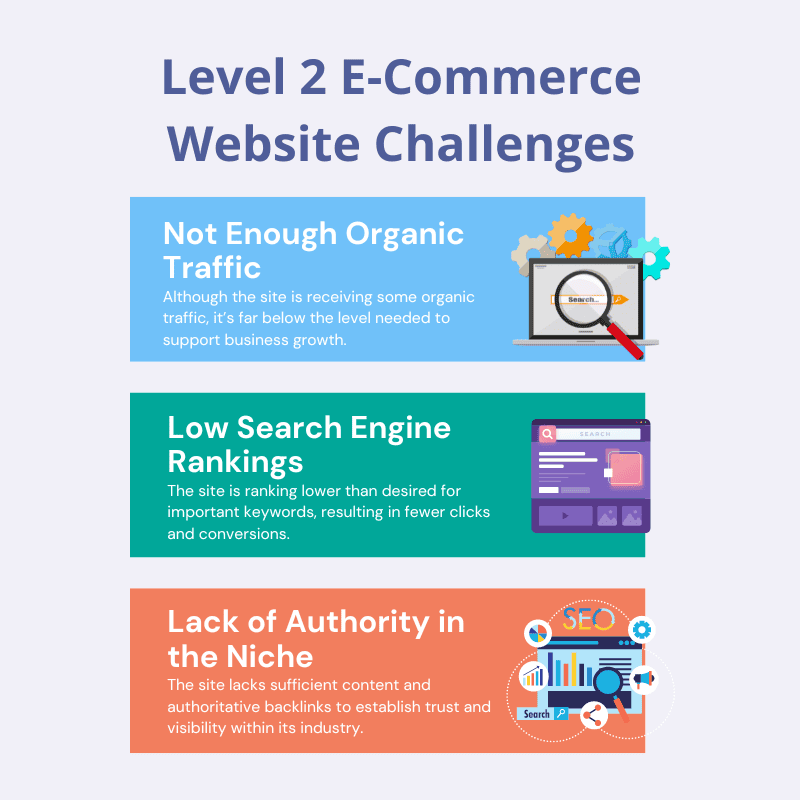What is SEO and what steps should you take to drive more customers to your website?
Search Engine Optimization (SEO) for e-commerce is not only about generating more traffic to your site. It's about naturally attracting the right people to your site—those who are searching for exactly what you offer—without the use of paid ads. And unlike paid ads where the traffic stops when spending stops, SEO is a long-term strategy that can lead to sustained growth.
Do you ever wonder what makes certain websites show up on the first page of Google Search Engine Results when you type a product into the search box? For example, why does H&M show up as the top result for “women’s loungewear” while other sites offering the same products are buried past the second page and beyond where most search engine users won’t bother to browse?
E-commerce SEO encompasses many interrelated parts—and to complicate things further, every company needs its own tailored strategy to tackle SEO, depending on its unique business goals and current status of its website.
But before you spiral into a deep state of overwhelm, the good news is there are a set of universal SEO best practices that apply to all ecommerce businesses. So the first step to dealing with your SEO is to understand it.
Whether you decide to do SEO in-house, enlist the help of SEO experts to take care of the job, or a combo of both, you need to start with having a basic understanding of SEO and how it works. Once you know about the components of this marketing channel and how it fits into your overall marketing strategy, you can better structure your website and create content that will drive more visibility and sales.
How to Get Started with SEO for E-commerce
I find that the best way to explain SEO is to break it down into three levels from foundational, intermediate to advanced. The SEO initiatives involved in each higher level builds from the previous level.
Level 1: Foundational SEO
Level 2: Intermediate SEO
Level 3: Advanced SEO
In the following sections, you will learn:
- The main goal for SEO in each level.
- How to determine which level your website is currently in.
- Best practices in each level to optimize your site and drive more organic traffic.
Let’s get started!
Level 1: Foundational SEO “Get in the game!”
Your goal in Level 1 is to “get in the game” of SEO. You want to start getting your pages to rank for relevant keywords and be discovered by your target audience on search engines such as Google.
How do you know if your website is at Level 1?
If you have done little to no SEO for your site, or if you’re struggling with low organic traffic and visibility, then you’re likely at Level 1. This means your pages aren’t ranking well for the keywords that matter, or they’re not ranking at all.
Level 1 E-commerce Website Challenges:
What SEO best practices do you need to do at Level 1?
In this section, I will take you through these seven steps to get your website on its way to generating more visits by the people you are trying to target:
- Site Audit
- Setup Google Analytics and Search Console
- Technical SEO
- Keyword Research
- Keyword Mapping
- Basic On-Page SEO
- Image SEO
What is an SEO Website Audit?
Regardless of which level your website is currently in, your first step in the SEO journey is to conduct a full SEO website audit. Note that the audit can only be performed on live sites.
Just like looking under the hood of a car to determine if it’s driveable for the long-term, the site audit acts as a health check, uncovering what’s working and what needs improvement.
A full site audit report provides a comprehensive overview, including a technical SEO check and a website health score. It identifies the number of issues found, categorized by severity—such as errors, warnings, and notices—and highlights the top issues you should prioritize for fixing.
You would need a tool to run this comprehensive site audit. There are various tools available on the market, and our agency uses SEMrush.
Why is it so important to take the time to audit your site? Because if you don’t first address the existing problems that are holding back your site’s performance, any further SEO efforts will be ineffective.
What is Google Analytics and Google Search Console?
Before we get into technical SEO and keyword research, let’s pause a moment to talk about two key players in SEO: Google Analytics and Google Search Console. In order to get a clear picture of how your website is performing you need to have Google Analytics and Google Search Console properly set up.
What’s the difference between these two features, and how do they factor into the tracking of your website’s performance?
Google Analytics provides insights into where your traffic is coming from, who your visitors are, and how they interact with your site.
Google Search Console reveals which keywords and pages your site is ranking for, and it also flags any crawl errors or security issues.
Together, Google Analytics and Google Search Console form the backbone of your SEO monitoring, helping you track progress and make informed decisions to get the most return on your SEO investment.
Now that you know what these Google features are, let’s move on to the next sections!
What is Technical SEO?
After identifying priority issues in the site audit, you will need to tackle your technical SEO.
Technical SEO focuses on optimizing the backend of your website to ensure it can be effectively crawled and indexed by search engines like Google and Bing. It also addresses critical issues such as fixing errors, broken URLs, and redirects, auditing load speed, checking for toxic backlinks, and ensuring your site is mobile-friendly.
It’s surprising how often pages aren’t being properly crawled or indexed, even when everything seems to be running smoothly. If search engines can’t crawl your site, it’s as though you’re invisible online. Addressing these technical issues is the foundation for all other SEO efforts. Once these problems are resolved, your site will be in a strong position to implement the higher levels of SEO strategies and effectively compete in search rankings.
What is Keyword Research?
Keyword research is about understanding what your customers are searching for so you can create content that attracts them. The objective is to find the keywords that are most relevant to your business, so you can optimize your website to rank for those terms and attract the right audience.
Many new websites struggle to attract customers to their site, experiencing low traffic, because they are not targeting the right keywords—those that match what people are typing into their search engines.
Another problem might be that their urls do rank for relevant keywords, but the positions are very low. For example, a dress company might rank for “cocktail dress”, a relevant keyword for their cocktail dress collections page, but unfortunately, the url’s position is page 5 or 6 of Google Search results.
So how can you address these issues using keyword research?
Check Google Search Console to see which relevant keywords you are currently ranking for—in other words, which relevant keywords are search engine users typing in, that ultimately result in bringing those users into your website?
If you're already ranking for certain keywords, don't rush to change things. When keywords perform well, it's a sign to refine, not reinvent. SEO isn't about constant shifts—you can make small tweaks where needed. Sometimes, the best approach is to enhance what's already driving traffic rather than chasing new keywords.
Next, brainstorm new keywords that are relevant. List all possible words and phrases your customers might use, considering both short-tail (e.g., "shoes") and long-tail (e.g., "best running shoes for flat feet") keywords. Short-tail keywords are broad and attract high competition, while long-tail keywords are more specific, often attracting more relevant traffic with lower competition.
Finally, you can borrow relevant keywords from your competitors. Check out their websites to get insights into what keywords they might be targeting. Make sure that you are analyzing your “true SEO competitors”—businesses that offer similar products, same target audience and similar brand ethos.
Once you have a list of brainstormed keywords, tools such as SEMrush can help you refine your list by analyzing search volumes, keyword difficulty, and search intent.
This process will help you decide which keywords are worth targeting. Aim for those that balance attainability with the potential to drive relevant traffic. Occasionally, you'll find a keyword with high volume and low competition—a great opportunity to boost your site’s visibility!
Remember! The secret to effective SEO is to focus on relevance versus high quantity. You shouldn’t be trying to rank for everything. Instead, be strategic and target specific keywords that align with your business goals.
What is Keyword Mapping?
Keyword mapping is about organizing and grouping similar keywords together and then deciding which keywords will be the focus for each specific page on your site. This step in the SEO process is important because it helps ensure that your site is optimized efficiently, with each page targeting the right audience.
How does keyword mapping work? Here’s a quick overview of the steps:
Start with keyword research and competitor analysis to gather a list of relevant keywords.
Group those keywords by similarity, looking at things like general terms, specific styles, or even customer intent.
Finally, assign each group of keywords to the most appropriate page on your site, making sure each page has a unique focus keyword.
If you don’t do keyword mapping, you risk competing with yourself by using the same keywords on multiple pages, which can confuse search engines and dilute your rankings, ultimately reducing your site's visibility and traffic. We call this unfortunate situation “keyword cannibalization”—yikes!!
What is On-Page SEO?
After you have completed your keyword research, SEO competitor analysis and keyword mapping, you can start to plan and implement for on-page SEO. On-page SEO ensures that search engines easily understand the content on your pages and can match it with the right search queries.
Unlike technical SEO which deals more with the backend aspects like site speed, mobile-friendliness, and indexing—on-page SEO deals with elements such as focus keywords, title tags, meta descriptions, headings, block text, blogs and internal links. In other words, on-page SEO is where you implement your keyword research and mapping in the form of meta tags directly onto your website’s Content Management System (e.g. Shopify, WordPress, etc.) so that SEO efforts can have an effect and appear on SERPs (Search Engine Results Pages). Meta tags are snippets of text that describe a page's content. Meta tags don't appear on the page itself, but in the page's source code. They are essentially little content descriptors that help tell search engines what a web page is about.
What a title tag / meta description looks like in SERPs
You can find meta tags in the HTML code by navigating to the 'head' of the webpage's source code. Right-click on a non-hyperlinked area of a page and select "View Source" or "View Page Source" to inspect the tags.
Where the data was entered in the Content Management System (Shopify)
Will doing on-page SEO make a difference for your business?
Yes—it directly impacts your site's visibility and click-through rates, which ultimately affects your chances of making sales. If you don’t do it, your site may struggle to rank, leading to lower traffic and fewer conversions.
View client case study for inPhorm Activewear
What is Image SEO?
When building your website’s foundation for SEO, don’t forget about your images!
Image SEO is the process of optimizing the images on your website so they can be easily found and indexed by search engines, helping to improve your site’s overall SEO.
The objective of this step is to enhance your image’s visibility in search results and improve your pages’ load times. This involves creating descriptive file names, adding alt text that includes keywords, compressing images for faster loading, and ensuring they are responsive across devices.
Image SEO improves your user experience but also drives additional traffic through image search results. If you neglect image SEO, you risk slower page load times, poor user experience, and missed opportunities for traffic from image searches, all of which can negatively impact your site's overall performance and rankings.
Level 2: Intermediate SEO Building Trust and Authority
Your goal in Level 1 was to “get in the game” of SEO. You wanted your pages to start ranking for relevant keywords and get discovered by your target customers on search engines like Google.
Now that you’ve laid the foundation, your goal in Level 2 is to build trust and authority through content strategy and engagement. At this stage, you’re focused on improving your rankings, driving more organic traffic, and establishing your site as a credible source in your industry.
How do you know if your website is at Level 2?
If your site has been around for a while, you’ve done some SEO, and you’re getting some traffic but not enough to make a significant impact, you’re likely at Level 2. This means your site is ranking for some keywords, but you need to build on that in order to position your brand as the go-to site worth rewarding with top page rankings in SERPs.
Level 2 E-commerce Website Challenges:
What SEO best practices do you need to focus on at Level 2?
In this section, I’ll guide you through these key strategies to strengthen your site’s presence and build trust with both search engines and your audience:
- Blog Content Strategy
- Internal Linking and Topic Clusters
- High Quality Blogs
- Link Building
What is Blog Content Strategy and Creation?
Blog Content Strategy involves creating a data-informed plan for the topics, keywords, and types of content that will be published on your blog. Instead of just creating content for the sake of content, the strategy is about ensuring that every piece of content you create aligns with your overall SEO goals and targets the right audience.
The objective of a blog content strategy is to build authority, drive organic traffic, and engage your audience by consistently publishing valuable content that addresses their needs and interests. This involves identifying relevant topics, conducting keyword research, and planning a content calendar that keeps your blog active and aligned with your business goals.
How is it Done? Start by researching what your target audience is searching for and identifying gaps in the content currently available. Use this information to plan blog posts that fill these gaps and offer unique insights. Next, create a content calendar that schedules regular blog updates, ensuring your site remains fresh and relevant. Each blog post should be optimized with target keywords, engaging headlines, and strong calls-to-action to guide readers toward your desired outcomes.
Why is Blog Content Strategy Important? Without a solid blog content strategy, you risk publishing content that doesn’t resonate with your audience or fails to support your SEO goals. This can lead to missed opportunities for traffic, lower engagement, and a lack of authority in your niche. Websites seen as having “low authority” are given lower rankings in search engine results.
What is Internal Linking and Topic Clusters?
It takes time and effort to write your blogs, so if you want the most return on your investment from them, you should use internal linking and topic clusters. Internal linking and topic clusters boost your site’s authority and improve user experience by showcasing depth and expertise around key topics, leading to better rankings in search results.
Internal Linking is the practice of linking one page of your website to another. This not only helps users navigate your site more easily but also helps search engines understand the structure of your site and the relationship between different pages.
Topic Clusters involves creating a hub of content around a central topic, with one main pillar page that provides a comprehensive overview and several related sub-topic pages that explore specific aspects of the central topic in more detail. Each sub-topic page is linked back to the pillar page, forming a cluster that signals to search engines that your site has deep expertise on the subject.
Before you begin writing your blogs, it’s best to pre-plan your topic cluster. Start by choosing a broad yet focused core topic relevant to your brand and audience. Perform keyword research to identify target keywords for each sub-topic page in your topic cluster.
Without a proper topic cluster and linking structure, your disorganized content will lead to lower ranking for keywords, especially the ones with higher competition. You may struggle to demonstrate your expertise to search engines, limiting your visibility and authority in your niche.
What are High Quality Blogs?
High-quality blogs are well-crafted original articles that offer value to your audience. They bring awareness, build trust, drive organic traffic, and boost engagement (know, like, trust)—all while enhancing your site's SEO.
In order to give value to your target audience, start by understanding their needs, interests and pain points. Plan your content with a clear structure, including an engaging introduction and informative body, and maintain a consistent publishing schedule.
Focus on providing actionable, well-researched insights that will appeal to your human readers, and incorporate relevant keywords and formatting that follows the on-page SEO best practices that were previously mentioned under Level 1. Encourage reader interaction with calls to action that internally link to other content in your topic cluster or products where applicable.
You can use my blog writing template and blog quality checklist to make sure you hit all marks!
What happens when you produce low quality blogs? Not surprising, poorly written blogs result in low reader engagement, little trust, and poor search rankings. In fact, Google is becoming more active in removing unhelpful content from their index. This means that low quality blogs might not get seen at all on Google search results.
What is Link Building?
Link building is the process of acquiring hyperlinks, or "backlinks," from other websites to your own. Backlinks build your site’s authority because they act like votes of confidencel. They signal to search engines that your content is valuable and trustworthy—and therefore worth rewarding with higher rankings on search engine results.
If you want to earn more backlinks to your pages, you should create high-quality content that attracts natural links. You can also engage in guest blogging and replace broken links on other sites with your content. If you neglect link building, your website may struggle to gain authority and visibility.
Level 3: Advanced SEO Continuous Improvement
Your goal in Level 2 was to build trust and authority through content strategy and engagement, improving your site’s visibility and establishing your brand as a credible source in your industry.
Now, as you move into Level 3, your focus is on continuous improvement and staying ahead of SEO trends. At this advanced stage, you’re fine-tuning your strategies, experimenting with new tactics, and making sure your site stays competitive in an ever-evolving SEO landscape.
How do you know if your website is at Level 3?
If your site is already ranking well for many of your target keywords, you’re getting consistent traffic, and you have a solid content and link-building strategy in place, then you’re likely at Level 3. This means you’re looking to refine your approach, keep up with algorithm changes, and push your site’s performance even further.
Level 3 E-commerce Website Challenges:
What SEO best practices do you need to focus on at Level 3?
As your website grows and you add more collections and pages, you should continue to follow the best practices discussed in Levels 1 and 2. Meanwhile, here are some additional advanced strategies at Level 3 that will give your site an even stronger competitive edge and ensure long-term success:
- Performance Review, Analysis and Planning Next Steps
- Advanced Content Optimization and Refreshing
- Responding to Latest SEO trends and Future-Proofing Your SEO Strategy
What is SEO Performance Review, Analysis and Planning Next Steps?
Performance review, analysis, and planning next steps involve regularly assessing how your SEO efforts are performing—checking rankings, traffic, and user engagement—and identifying what’s working and what needs improvement.
You’ve made significant progress on your SEO journey, so keep maintaining that momentum!
Start by reviewing key metrics in tools like Google Analytics and Search Console, focusing on which keywords are driving traffic, how your rankings are evolving, and whether visitors are engaging with your content. Based on these insights, you can decide whether to update content, adjust keyword strategies, or address technical issues.
Without regular analysis, you risk wasting time on ineffective strategies, missing opportunities for improvement, or even losing traffic and rankings without realizing it.
What is Advanced Content Optimization and Refreshing?
Advanced content optimization and refreshing involves revisiting and updating your existing content to enhance its relevance, quality, and performance in search engines.
The objective is to improve search rankings, keep your audience engaged, and ensure your site remains competitive and authoritative in your niche.
After analyzing content performance, you can then identify areas for improvement, and make updates like adding new information, optimizing for relevant keywords, improving readability, and enhancing multimedia elements such as images and videos.
You have to keep your content refreshed because when it becomes outdated, it loses relevance, and drops in rankings, leading to less traffic, less user engagement, and a loss of credibility with both your audience and search engines.
What is Responding to Latest SEO Trends and Future-Proofing Your SEO Strategy?
Staying ahead of SEO trends and future-proofing your strategy means actively adapting to changes in the SEO landscape to keep your site competitive. You want your rankings, traffic, and performance to continually improve despite shifts in algorithms, user behavior, and industry standards.
To do this, regularly monitor industry news, algorithm updates, and new SEO techniques, and be ready to pivot by experimenting with strategies and tools. If you don’t keep up with these trends, you risk falling behind your competitors who are willing to adapt.
One easy way to keep up with the latest news is to subscribe to newsletters by experts in the field.
Congrats! You just completed the full overview of SEO!
As you can see, SEO is not a one-and-done deal. It’s an ongoing process that grows with your business. Whether you’re just starting out or refining an established strategy, applying the right practices at each level will bring long-term success—while choosing to ignore those best practices could hurt your online visibility and credibility.
Get in the game, then stay ahead of your competition by building a strong foundation, boosting your site’s authority, analyzing your performance and improving your strategy. Remember—SEO isn’t just about climbing the ranks—it’s about attracting, engaging, and converting the right audience, so your business can thrive.
Keep learning, adapting, and fine-tuning your approach to see results that last.
_______________
Need SEO support for your website?
If you think SEO is time-consuming and complex—you’re right!
Find the support you need right here. From site audits to full SEO and blog writing services, my team and I can help get your SEO on track.









